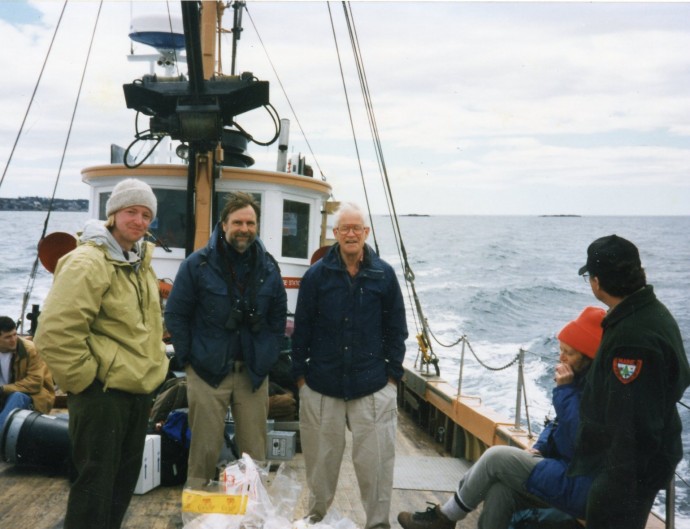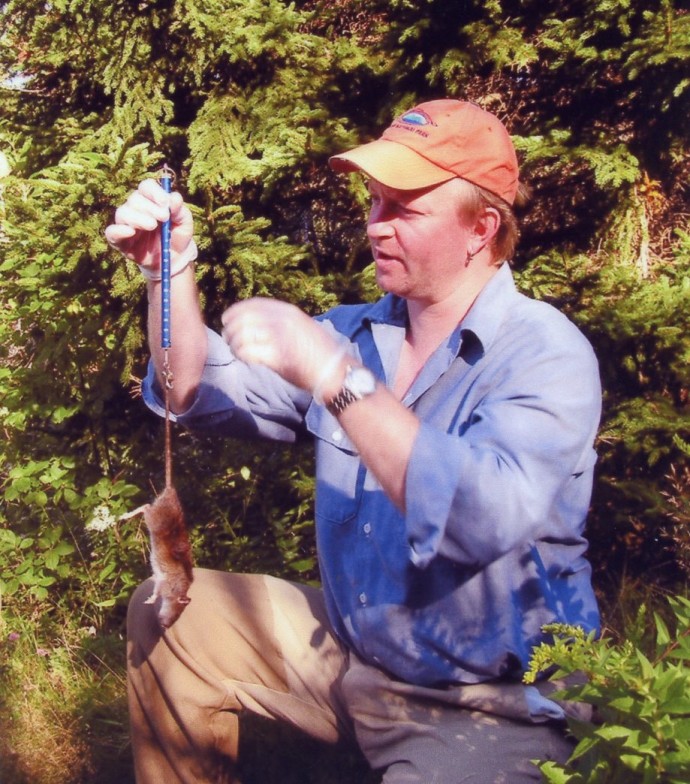Lyme disease was not identified until 1975 in Lyme, Connecticut, and it wasn’t until 1987 that Lyme disease was identified in Maine. Before the 1980s, you couldn’t even find ticks in the Pine Tree State. In 1989, however, the first case of Lyme on Monhegan Island was diagnosed.
What made Monhegan such an odd case was its lack of mice. The conventional wisdom in the late 1980s was that ticks couldn’t exist in a region that lacked either mice or deer (the two primary hosts at different stages of the deer tick’s life cycle). It did not take long for researchers to deduce that Monhegan’s Norway rats were the host that substituted for common field mice. Interestingly, both the deer and the rats on Monhegan were introduced to Monhegan’s ecosystem by humans. In order for the Lyme problem to be solved for good, either of those hosts also needed to be eliminated by humans.

Chuck Lubelczyk, Dr. Pete Rand, and other members of the Vector-borne Disease Lab aboard the Laura B, making the 12 mile trip from Port Clyde to Monhegan during their research.
Doctor Peter Rand and Chuck Lubelczyk recounted the story of solving the Lyme problem on Monhegan. Together with Dr. Robert Smith and researchers Eleanor Lacombe, Mary Holman and Susan Elias from the Lyme & Vector-borne Disease Laboratory at the Maine Medical Center Research Institute, they were involved with the expulsion of Lyme disease from the island in the 1990s. Chuck and Pete are two respected experts when it comes to ticks in Maine, and both men have worked with vector-borne diseases for decades.
HOW IT WORKED
Originally it was thought that mice were the primary host—and they still are a major host—but chipmunks, red squirrels, and other small mammals can also be host to the tick. And those animals maintain the infection within them.
Dr. Peter Rand
ATTEMPT NUMBER ONE:
The first plan was to treat the rats with a pesticide that would kill the ticks on them. The plan was to stick bait inside two-foot plastic tubes rimmed on each end with a pesticide that would coat the rats and kill the ticks on them. However, the tubes quickly became infested with slugs, thwarting the experiment.
ATTEMPT NUMBER TWO:
The second solution was to kill the rat population. The rats lived in close proximity to the humans which made this challenging. The poison was administered to the rats, but before the population could be significantly reduced, one dog became ill after attacking a poisoned rat, and the experiment was called off.

Chuck Lubelczyk weighing a rat on Monhegan
ATTEMPT NUMBER THREE:
The United States Department of Agriculture had a method of eliminating ticks by feeding deer ivermectin (a substance used to treat heartworm and various tropical diseases). The deer were fed corn laced with ivermectin, but after two years, while partially effective, the approach was too expensive and labor intensive to be maintained,
It looked like if that had continued, it may have been successful… but by the time we got to that stage, Lyme disease had increased a lot on the island, and the islanders were becoming very anxious to get rid of the deer. One of the things that drives Monhegan’s economy is the tourist season which lasts only 10 weeks, so they didn’t want people not coming to Monhegan because of the threat of Lyme disease.
The desire to get rid of the deer increased—plus, the island was becoming covered with barberry because the deer didn’t eat it, but they’d eat everything else. So, this invasive species was going wild. After several meetings and great involvement with the Department of Inland Fisheries and Wildlife, the final vote was to get rid of the deer by using a very professional sharp shooter.
Dr. Peter Rand
ATTEMPT NUMBER FOUR:
Anthony (Tony) DeNicola completed his doctorate at Purdue on deer population control, and shortly after he was asked to kill every deer on the island of Monhegan. He was the founder of a non-profit called White Buffalo which was committed to conserving native species and ecosystems through wildlife management. Tony used baiting stations which he monitored at night and used night vision scopes to identify and dispatch the deer. Between April 2nd and April 6, 1997, 52 deer were killed. They were extremely malnourished due to over population. There were estimated to be about 25 deer remaining on the island, so a vote was taken at a town meeting in March of 1998 to decide whether or not the remaining deer should be killed. The results were: 31 yes and 23 no. By the following March, there were no more deer left on Monhegan.
Since then, there have been only two cases of Lyme disease on Monhegan.
Q & A WITH DR. PETER RAND AND CHUCK LUBELCZYK

Why is Monhegan’s geography special in relation to its experience with ticks?
CL: Matinicus and Monhegan are both far away from the mainland (about 15 miles and about 12 miles from the mainland respectively). If an island were to have a massive reduction of deer, the mainland would be your source of deer coming back out or repopulating. One of the issues with islands that are close to the mainland or—as in Casco Bay—islands that are close to one another is that the deer have no hesitation to jump in the water and swim across a body of water. On Casco Bay islands, we hear stories of a hunt starting say for instance on Peaks Island, and the deer just jump off and swim to Long Island. When the hunt starts on Long and they swim to Peaks they swim to Great Diamond or someplace else to get away from the hunters.
What can you tell me about pesticide use as a means of fighting Lyme?
CL: One of the primary tools for us to control ticks has been and still is the application of pesticides. Frequently these pesticides are spread at the landscape level around properties. However, there’s a degree of hesitation and wariness on the part of island communities to apply these because there’s a big concern that these things are going to run off into the estuaries and into areas where you may have lobstering and other kinds of shellfishing going on. And so islands are very hesitant to use one of the primary tools to actually control ticks. I think it speaks to the need for having a very detailed program on each island. And certainly taking into account each community’s needs or preferences for having some kind of tick control. It’s not a broad-brush approach. You have got to treat each island almost individually, and you have to craft a tick management program to each island’s needs.
What has it been like working with islanders on the issue of combatting Lyme disease?
PR: We had some extremely devoted folks—that’s where Islesboro comes to mind—they had a committee out there that’s really dedicated to educating the people and making them aware of what was going on.
CL: Peter brings up a really good point: having people on the islands that care about this issue and care about it from an educated and rational perspective… Ones that don’t want to engage in hysteria but want to actually have the facts and have the good information on hand and present to the island and make a case. And though we are talking about deer a lot, really what we’re talking about is tick control—some kind of community-based tick control project, and one of the real legs of that stool on the islands are the island health centers. There’s no way on many of the coastal islands that we could have the surveillance programs that we do without really good cooperation from these island health centers. Because they really are the focal point for information on the islands. They provide us with a very good center location for a base of operations if we come out to these islands, they are a good point for us to investigate. They know what’s on the ground of these islands. They know where people are finding ticks, they know who has gotten Lyme disease on the island. So, they are an excellent resource for both us and the island communities. And I think there is a direct relationship between how successful some of our work has been on Maine islands and the ability of these island health centers to really help us out.
The interview above has been edited for length and clarity.
RESOURCES
- Ticks and Lyme 101– The rest of the interview with Chuck and Peter in which they describe the history of Lyme and the ecology of the deer tick
- Lyme & Vector-borne Disease Laboratory’s website
- Island Survey Preliminary Report March 2017
Originally Published March 2019

